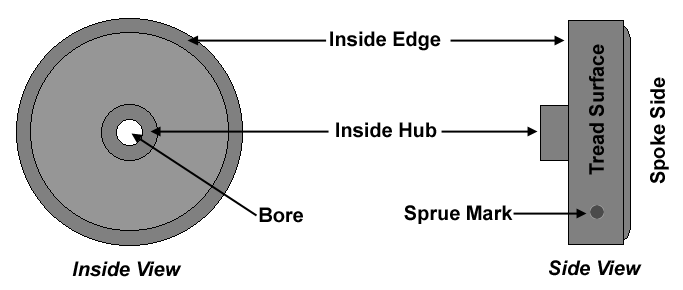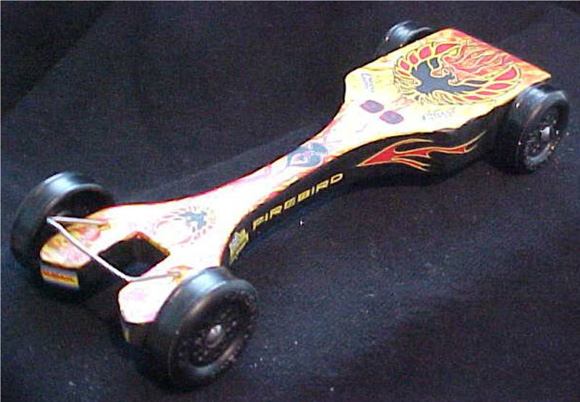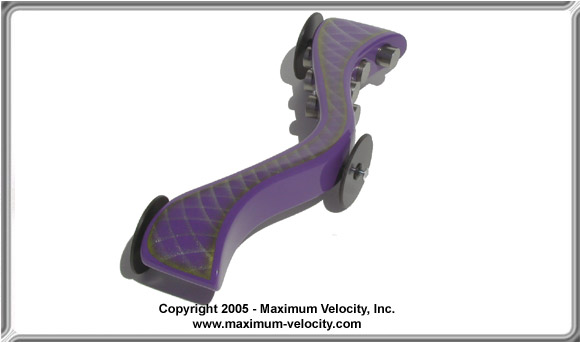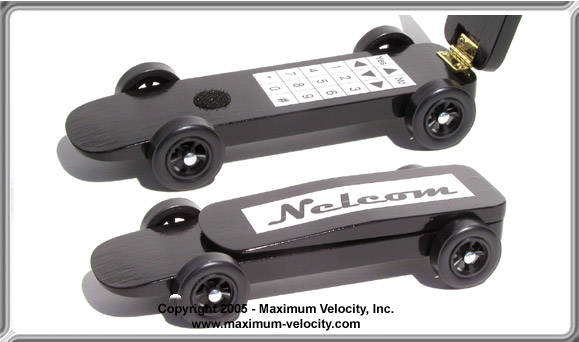– Feature Article – Pinewood Derby Glossary: Part 2
– Car Showcase
– Q&A
Pinewood Derby Glossary: Part 2
Several weeks ago the first half of this glossary was provided. As mentioned then, every sport, hobby, or business has a collection of special terms, sometimes called ‘jargon’. This goes for pinewood derby racing as well. So here is the second part of the glossary. If you find a term I have missed, please e-mail them to me and I will update the glossary at a future date.
RACE MANAGEMENT
Ballistic Stoppers – Removable devices that can be placed on the braking section of the track to more quickly slow down cars.
Braking Section – A final section of a track used for slowing down cars.
Center Guide – A track type on which cars straddle a lane guide.
Elimination – A method of racing which narrows down the field by eliminating losing cars.
Garage – A stopping device generally made of foam rubber placed at the end off a track into which the cars roll.
Judge – A device (or person) that determines the finish order, but does not capture the heat times (not to be confused with “The Judge”, a product by New Directions which can be equipped with a timer).
Lane Rotation – A method of racing whereby each car races the same number of times on each lane, and with the widest possible variety of opponents. Variations include Perfect-N, Partial Perfect-N, and Complimentary Perfect-N.
Laser Gate – A system which starts the heat timer when the first car breaks a light beam, instead of when the starting gate is tripped.
Side Guide – A track type on which cars rest between two lane guides.
Starting Pins – The posts behind which cars are held at the starting line.
Stearns – A method of racing which assigns cars to specific lanes for each heat. Generally this method has been replaced by ‘Lane Rotation’ methods.
Timer – A measuring device which captures the heat time on each metered lane.
SPECIALTY TOOLS
Alignment Tool – A plastic gauge capable of making several measurements to better align the wheels of a car.
Go/No-go Box – A device used at inspection to determine if a car meets the race specifications.
Pro-Axle Press – A tool for straightening nail-type axles.
Pro-Body Tool – A drilling guide for creating axle holes, or for making pilot holes in axle slots.
Pro-Bore Polisher – A tool for polishing the wheel bore.
Pro-Hub Tool – A tool for squaring and/or coning the inside wheel hub.
Pro-Outer Hub Tool – A tool for squaring the outside wheel hub on BSA wheels.
Pro-Wheel Shaver XT – A tool for truing and machining the tread surface.
Wheel Balancer – A tool for identifying the heavy side of a wheel in order to balance the wheel.
Wheel Mandrel – A tool for holding a wheel in a drill or lathe in order to polish or machine the spinning wheel.
STANDARD TOOLS / SUPPLIES
Calipers – A device for accurately measuring thickness, depth, etc. Commonly used for measuring the diameter of wheels and axles.
Certified Test Weight – A weight certified to be highly accurate. Commonly used for verifying/proving the accuracy of a scale.
Chisel – A hand tool with a sharp beveled edge for removing excess wood. Commonly used for creating pockets for ballast weight.
Clamp (C-type) – A holding device in the shape of a ‘C’, used for holding the block of wood for drilling, cutting, etc.
Drill Bit (Brad Point) – A type of bit with ‘flutes’ for drilling clean accurate holes in wood. A sharp tip ensures that the bit does not wander.
Drill Bit (Forstner) – A type of bit without ‘flutes’ for drilling very clean accurate holes in wood. A sharp tip ensures that the bit does not wander.
Drill Bit (Fractional) – Drill bits measured in fractions of an inch, e.g., 1/8, 3/16, 1/4, etc.
Drill Bit (Numbered) – Drill bits measured in number units, e.g., 44, 45, 46, etc. Numbered bits have much smaller increments than fractional bits.
Level – A device to verify the evenness of a surface. Commonly used for adjusting a track, or for adjusting a test surface to be used for aligning a car.
Saw (Coping) – A light handsaw with a slender blade stretched across a U-shaped frame, used for cutting designs in wood.
Saw (Hack) – A handsaw having a narrow blade stretched in an iron frame, for cutting metal. Commonly used for making accurate cuts in wood, and for cutting new axle slots.
Shim – A thin piece of material used for making fine position adjustments. Waxed paper is commonly used as shim material for making adjustments to the alignment of a car.
Square – A device for marking and measuring right angles. A common type is the ‘Combination Square’, which also marks 45 degree angles and can be used as a ‘level’.
Vise – A fixed holding device with strong jaws. Commonly used to hold a car body for cutting, drilling or shaping.
Wood Filler – A water-based, paintable substance used for filling gaps and flaws in wood.
Wood Putty – An oil-based, generally non-paintable substance used for filling gaps and flaws in wood.
X-acto Knife – A brand of razor knives used in hobby work.
TOOL TECHNICAL TERMS
Chuck – The portion of a drill or lathe which holds the drill bit, mandrel, or other object.
Flutes – The spiral grooves on a drill bit for channeling cut wood out of the hole.
Kerf – The width of a saw blade. When cutting new axle slots, the kerf of the blade should match the slot width.
WEIGHT
Ballast – Any weight used to increase the mass of the car.
Hobby – Typically zinc formed into a variety of shapes.
Lead – A soft, heavy metal used as ballast weight.
PineCar – Same as ‘Hobby’.
Plate – Zinc weight formed in a thin plate for attaching underneath a car.
Tungsten – A hard, heavy metal used as ballast weight.
Zinc – A hard, light metal used as ballast weight.
WHEEL (See Figure 1)
Bore – The hole through which the axle passes.
Face – The sides of the wheel, the side facing away from the car is the ‘spoke side’ or outside face, while the side facing the car is the inside face.
Hub – The portion of the wheel on which the axle head rubs (the outside hub), and which rubs on the car body (the inside hub).
Inside edge -The portion of the wheel which rubs against the lane guide on ‘center guide’ tracks.
Outside edge – Portion of the wheel which rubs against the lane guide on ‘side guide’ tracks.
Spoke side – The outside face of the wheel.
Sprue mark – A mark on a wheel formed during the molding process. It corresponds to the opening in the mold through which the plastic is poured.
Tread – The portion of the wheel which touches the track.
 Figure 1 – Wheel Terms
Figure 1 – Wheel TermsWOOD
Balsa – A very light-weight wood. Commonly found in hobby shops, it is useful for making accessory parts for pinewood derby cars. The BSA Space Derby and Raingutter Regatta kits are made from this wood.
Basswood – A soft, light-colored, even-grained wood. Also known as Linden. Commonly found in hobby shops, it is useful for making accessory parts for pinewood derby cars.
Pine – Any of a variety of soft, light-colored woods used for pinewood derby kits.
Ponderosa Pine – A soft western pine.
Sugar Pine – A soft, western pine noted for a sweet smell.
White Pine – A soft eastern pine.
Yellow Pine – A hard, southeastern pine with a yellow color. Also know as Longleaf or Shortleaf Pine.
(Note that BSA purchases blocks from several suppliers, so the block could be any of the above pine types.)
Some definitions in this glossary were adapted from those at: www.dictionary.com
Pinewood Derby Car Showcase
Low-Rider: Stephen & Stevie Banks

Snake Car: Elisa Davis

Nelcom: Janel Davis

Q&A
I recently read an article that claimed that a group added the weight inside the wheel. Have you heard of this and how beneficial is it?
Adding weight to wheels will slow down the acceleration of the car. Although a car with weighted wheels may roll for a greater distance than a car with light wheels, it can never catch up with a car with light wheels on a typical pinewood derby track.
How large does an object need to be to trigger an electronic finish line? I’m asking because I’ve seen many car designs that have a wire for the front of the car, often mounted high to take advantage of the starting gate drop time.
Per feedback from electronic finish line vendors, a wire may not be enough to consistently trip the line (although it can work as found out by Stevie Banks (see Car Showcase section). To ensure consistent tripping, an object of at least 1/4 inch thickness should be used. If a wire is used for the front, then you can stretch some tape (maybe metallic) across the front.
The first two years my son competed in his pinewood derby he painted his entire car and then clear coated it. The last two years we have left the area where the inner wheel hub touches the body unpainted. Which of these do you think makes a slicker surface (or faster car)?
I prefer the clear coat, but in either case, if you are using graphite as the lube, then rub some graphite on the area.
Want Answers?
Do you have a pinewood derby-related question? If so, e-mail us your question.We answer all questions by e-mail, but not every question will appear in the Q&A section of the newsletter.
Back Issues
Are you a new subscriber, or have you missed some of the previous newsletters? Don’t miss out; all of the issues for Volume 5 through Volume 17 are posted on our web site.
Newsletter Contributions
We welcome your contributions. If you would like to contribute an article, a web site review, a speed tip, or a pinewood derby memory, please e-mail us.
Subscription Information
The Pinewood Derby Times is a free e-newsletter focused on pinewood derby racing. It is published biweekly from October through March.
If you haven’t already done so, please forward this issue to your pinewood derby friends. But please don’t subscribe your friends. Let them decide for themselves. Thanks.
If this newsletter was forwarded to you, why not subscribe to receive this newsletter. There is no cost, and your e-mail address is safe, as we never sell or share our distribution list.
To subscribe, send a blank e-mail to
[email protected]
You will receive a confirmation e-mail. Reply to the confirmation e-mail and you will start receiving the Pinewood Derby Times with the next issue.
Randy Davis, Editor, Pinewood Derby Times
E-Mail: [email protected]
(C)2018, Maximum Velocity, Inc. All rights reserved. Please do not reprint or place this newsletter on your web site without explicit permission. However, if you like this newsletter we grant permission, and encourage you to e-mail it to a friend.
Maximum Velocity disclaims any personal loss or liability caused by utilization of any information presented in this newsletter.
The Pinewood Derby Times is not specific to, and is not affiliated with the Boy Scouts of America, YMCA, Awana, or any other organization.
(R)Maximum Velocity is a registered trademark of Maximum Velocity, Inc.
(R)Pinewood Derby is a registered trademarks of the Boys Scouts of America.
(R)Awana is a registered trademark of Awana Clubs International.
All other names are trademarks of their respective owners.
